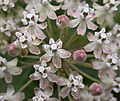Narrowleaf milkweed facts for kids
Quick facts for kids Narrow-leaf Milkweed |
|
|---|---|
 |
|
| Scientific classification | |
| Kingdom: | |
| (unranked): | |
| (unranked): | |
| (unranked): | |
| Order: | |
| Family: | |
| Subfamily: | |
| Genus: | |
| Species: |
A. fascicularis
|
| Binomial name | |
| Asclepias fascicularis |
|
Asclepias fascicularis, often called the narrow-leaf milkweed or Mexican whorled milkweed, is a unique species of milkweed plant. It belongs to a group of plants called Asclepiadoideae, which is a subfamily within the larger plant family Apocynaceae. This plant naturally grows in the western United States. You can usually see its flowers from June to September. Narrow-leaf milkweed likes to grow in dry areas and valleys.
Contents
What is Narrow-leaf Milkweed?
Narrow-leaf milkweed gets its name from its long, thin leaves. These leaves are usually arranged in a circle around the stem, which is why it's sometimes called "whorled." Like other milkweeds, this plant produces a milky white sap when its stem or leaves are broken. This sap helps protect the plant from animals that might want to eat it.
Appearance of the Plant
The plant can grow to be quite tall, sometimes up to 3 feet (about 1 meter) high. Its stems are usually straight and have many leaves. The flowers of the narrow-leaf milkweed are small and often pale green, cream, or purplish-white. They grow in clusters, forming a round shape. These flowers are very important because they produce nectar, which is a sweet liquid that attracts many insects.
Where Does It Grow?
Narrow-leaf milkweed is native to many parts of the western United States. You can find it in states like California, Nevada, Oregon, and Washington. It prefers places that are dry and sunny. This includes open fields, hillsides, and even along roadsides. It's a tough plant that can survive in different kinds of soil.
Why Is It Important?
Narrow-leaf milkweed is super important for many insects, especially butterflies. It's a key plant for the Monarch butterfly!
Monarch Butterflies and Milkweed
Monarch butterflies need milkweed plants to survive. Adult Monarchs lay their eggs only on milkweed leaves. When the eggs hatch, the tiny caterpillars eat the milkweed leaves. The milky sap that protects the plant also protects the caterpillars. It makes them taste bad to predators like birds. This is a special defense mechanism! Without milkweed, Monarch butterflies would not be able to complete their life cycle.
Other Pollinators
Besides Monarchs, many other insects visit narrow-leaf milkweed flowers. These include bees, wasps, and other butterflies. They come to drink the nectar from the flowers. While they are drinking, they help to pollinate the plant. Pollination is when pollen is moved from one flower to another, which helps the plant make seeds. This process is vital for the plant to reproduce and for the ecosystem to stay healthy.
Life Cycle of Narrow-leaf Milkweed
The life cycle of the narrow-leaf milkweed starts with a seed. When a seed sprouts, it grows into a young plant.
From Flower to Seed Pod
After the flowers are pollinated, they develop into interesting seed pods. These pods are long and narrow, shaped a bit like a canoe. When the pods are ripe, they split open. Inside, you'll find many flat, brown seeds. Each seed has a fluffy white "parachute" attached to it. This fluffy part helps the seeds float on the wind. This way, the seeds can travel far away from the parent plant and start new plants in different places. This is how the milkweed spreads its population.
Growing Conditions
Narrow-leaf milkweed is known for being able to handle dry conditions. It doesn't need a lot of water once it's established. This makes it a great plant for areas with less rainfall. It also likes full sun, meaning it needs many hours of direct sunlight each day to grow well.
Images for kids
See also
 In Spanish: Asclepias fascicularis para niños
In Spanish: Asclepias fascicularis para niños


